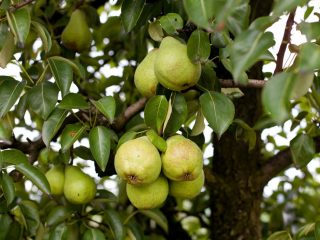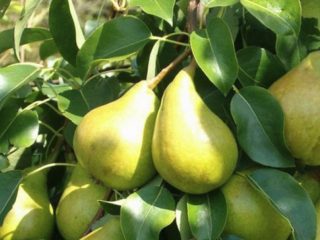Content
Pear varieties for Siberia are presented in a wide variety. It is quite possible to get a good harvest in a harsh climate if you choose the right type of fruit crop.
Climatic features of the region
Choosing a pear variety for Siberia is quite difficult - the region is poorly suited for growing fruit crops. The sharply continental climate is characterized by long and very cold winters, spring comes late, and even in early summer recurrent frosts can occur. Deep autumn in Siberia often begins as early as mid-September.
It is possible to grow pears in the region, but the tree needs to be provided with quality care. The crop needs to be fed regularly; for the winter, the plant is carefully insulated in the root area.
What variety of pear to plant in Siberia
Zoned varieties of pears are best suited for Siberia.Such trees have high immunity and good frost resistance, and are not damaged by late spring colds. Fruiting usually occurs in mid-summer or towards its end - the harvest can be harvested before the arrival of autumn.
It is recommended to plant two-year-old strong and healthy seedlings in open ground in Siberia. They take root most quickly in the ground. Planting is usually carried out at the end of spring or at the very beginning of autumn.
Frost-resistant pear varieties for Siberia
A pear for growing in Siberia, first of all, must be frost-resistant. Severe winters and sudden spring cold spells pose the greatest danger to fruit crops.
Firefly
The medium-sized pear has a spreading crown; the fruits on its shoots ripen in early autumn. The variety bears round yellowish-green fruits with smooth skin, which finally ripen during storage and acquire a golden color. The pear pulp is creamy, dense, sweet with sour notes. The harvest is stored for about three months in a cool, shaded place.

Firefly pear is well suited for long-distance transportation
Dalikor
The low, columnar species reaches 2 m above the ground. It bears large yellowish fruits with tender and juicy pulp. The taste of the variety is soft, creamy, very pleasant. The harvest ripens in early September, and if storage rules are followed, it can remain until the New Year. The total duration of fruiting for the Dalikor variety is average - about ten years.

Dalicor pears can reach 500 g in weight
Siberian
The pear variety ripens at the end of August and bears medium-sized sweet and sour fruits. It does not differ in dessert taste, but has other advantages - high frost resistance and good immunity to major fungi. It bears fruit abundantly and regularly, regardless of the weather, and produces a high-quality harvest in cold summers. Pear trees of this variety are medium-sized, with a rounded crown, and require periodic pruning.
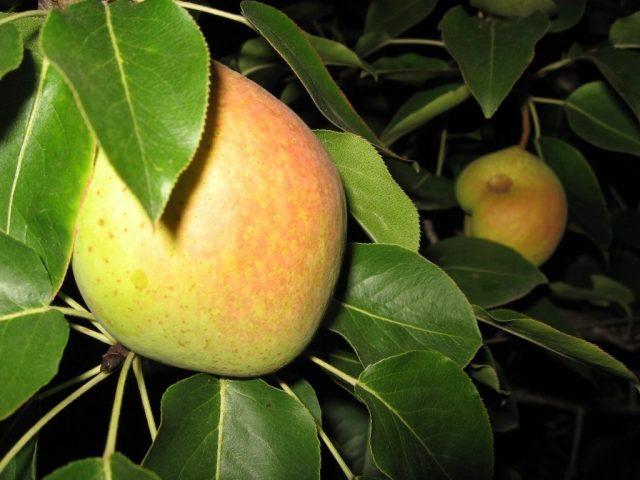
The Siberian pear bears fruit for the first time at 4-5 years of age.
Severyanka
A popular pear variety for Siberia can tolerate frosts down to -50 °C. Even after freezing, the tree easily recovers with the onset of spring. The crown shape is columnar, the plant is compact, great for small areas.
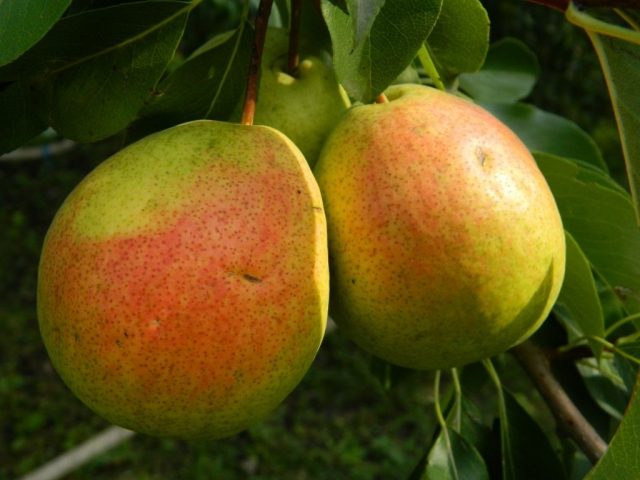
The fruit weight of the Severyanka variety is only about 100 g
The pear fruits are small, but juicy, with sour-sweet pulp. The structure is dense, the grain is medium. The fruits ripen around mid-August.
Taiga
A frost-resistant pear variety for Siberia can withstand the most severe winter and spring cold snaps. The variety bears greenish small fruits with oily white flesh. The fruit tastes sweet, almost without sourness, with a pleasant aroma. The weight of the fruit is on average 90 g. Ripening occurs at the end of summer before the onset of the first cold weather, and the harvest can last for about a month.

Taiga pear is rarely affected by gall mite and scab
Uralochka
One of the best varieties of pears for growing in Siberia tolerates frosts down to -45 °C.The fruits set small, the harvest ripens by mid-September. Ripe fruits are not prone to shedding and can remain on the shoots for up to a week and a half, but it is recommended to collect them on time so that they do not freeze.

The weight of the fruits of the Uralochka variety is on average only 60 g
The variety for Siberia is valued not least for its early fruitfulness. The tree bears its first fruits already in the fourth year after planting.
Carmen
The famous early variety produces a harvest at the end of July. Ripe fruits are never damaged by autumn cold. At the same time, fruits can lie until the beginning of November, if you provide them with comfortable conditions.
A large pear variety for Siberia, it has a sweet taste with an almost imperceptible sourness. There is no astringency in the pulp. The weight of the fruits can reach 180 g, and after ripening they emit a fruity aroma.

The Carmen variety is considered a long-liver because it grows up to 50 years in one place
Svarog
A good pear variety for growing in Siberia is not afraid of severe frosts and does not suffer from fungal diseases. It has good yield - an adult tree can bear up to 20 kg of fruit. The variety is medium-sized, capable of reaching 3.5 m in height, has a rounded crown, prone to thickening. The fruits are small, with a noticeable expansion at the bottom, with yellow skin and a slight reddish blush. The pulp is sweet with a slight sourness, juicy, semi-oily, with a faint pleasant aroma.

Svarog pear weighs up to 80 g
The Svarog variety can be harvested in Siberia at the end of September. Often the fruits are picked from the shoots a little earlier, and they ripen already in storage. Pears can remain in the refrigerator until the end of December.
Lukashovka
The vigorous pear bears fruit at the end of September. Fruits are formed large, elongated or round, up to 190 g in weight, with a short shelf life. The variety is frost-resistant, its yield is very high, but irregular. An adult tree in Siberia may not bear fruit every season, but every other year. The disadvantage of this variety is its poor resistance to fungal diseases.

Lukashovka pear produces a good harvest only if there are pollinating varieties nearby
Decabrinka
One of the best pear varieties for Western Siberia begins to bear fruit from the seventh year of life. It has good yields, fruit ripening occurs at the end of September. The variety easily tolerates winter frosts and is not damaged by fungi and parasites. When growing a variety in Siberia, pear trees with similar flowering periods must be planted nearby for pollination.
The variety bears compact fruits, up to 120 g, with a fruity aroma and a sweet dessert taste. Pears tolerate transportation well and can be grown for sale.
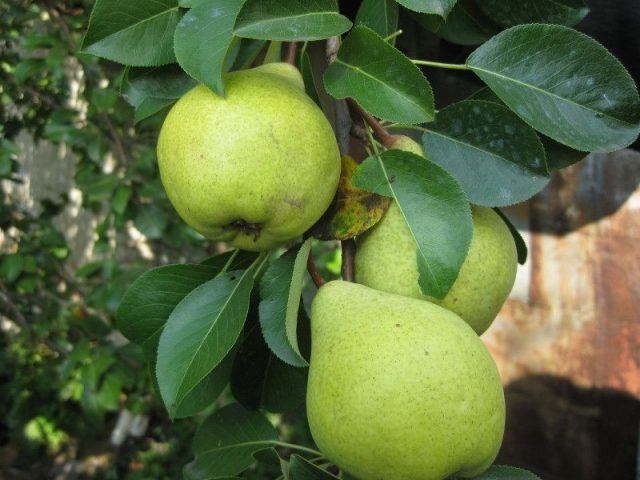
The harvest of the Dekabrinka variety can be stored for up to three months in suitable conditions.
Sweet pear varieties for Siberia
Sweet pear varieties are of particular interest to gardeners. Several varieties are well suited for planting in Siberia.
Isetskaya juicy
The frost-resistant variety is not affected by scab, but may suffer from gall mite and leaf spot. It has medium height and a rounded crown, and bears fruit in mid-September.The fruits of the variety are juicy, up to 110 g, with light yellow skin. A pinkish-orange blush may be visible on the surface. The pulp has an oily texture and a good sweet taste.

Isetskaya juicy has a short shelf life and can last for about a month.
Fabulous
A tall variety with a pyramidal crown produces elongated fruits with a rich yellow color. Pears taste sweet, emit a light aroma, and their flesh is slightly oily and dense. The weight of individual fruits can reach 200 g.
Each mature pear tree can produce up to 12 kg of harvest. Fruiting begins quickly - already in the second season after planting. At the same time, productivity indicators increase gradually.

The Fairytale variety easily tolerates frosts down to -35 °C with good shelter.
Pink barrel
The variety is well suited for the southern regions of Siberia and can withstand frosts of about -30 °C. The harvest ripens from early September to November, the fruits are greenish-yellow with a dark pink tan. The fruit tastes sweet, with a slight sour note.

After a hot summer, the Pink Barrel pear harvest is ripening faster than usual
Self-fertile pear varieties for Siberia
The best Siberian pear varieties are able to set fruit without the participation of pollinators. Such trees produce a good harvest even in cold summers, when there are almost no beneficial insects on the site.
Decor
A frost-resistant pear variety for Siberia sets fruit on its own. It is highly resistant to diseases, is not affected by pests, and easily tolerates winter frosts. Forms large, sweet fruits with a uniform yellow-green color and a light floral aroma.
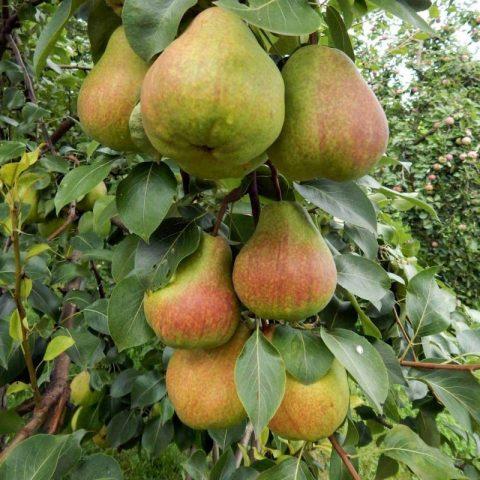
The weight of fruits of the Decor variety can reach 250 g
Ripening begins at the end of August, and the variety produces its first crop in the third season after planting. The trees have a compact crown, do not require complex care, and reach a height of approximately 2.2 m.
Karataevskaya
A popular variety for Eastern Siberia, it has been in demand among gardeners since 2011. It produces greenish, red-tanned fruits weighing up to 107 g and has a sweet and sour taste. The pulp of the fruit is tender, fine-grained, and of medium density. The harvest can remain in the refrigerator for up to two months.

Karataevskaya’s tasting score is 4.9 points
The variety demonstrates good resistance to fungi, but often suffers from scab and green aphids. It ripens in mid-September and produces crops regularly, regardless of the weather.
Otradnenskaya
Another good variety for cultivation in Eastern Siberia brings up to 40 kg of yield from an adult tree. It has good transportability and produces yellowish-green fruits with a blurred red blush. The pulp of the variety is creamy, the taste is sourish-sweet. In suitable conditions, the fruits can lie for three months.

Otradnenskaya ripens towards the beginning of October
Columnar varieties of pears for Siberia
Columnar pears have a compact crown. Such trees are easy to care for; pruning shoots does not cause any difficulties. With the onset of winter, columnar varieties can be covered without problems both at the roots and along the crown.
Honey
The summer frost-resistant pear ripens at the end of August and produces large fruits weighing up to 400 g. It does not make any special demands on the soil; with regular fertilizing, it can grow on poor soil. The fruits are uniformly yellow with an orange tan, oval-elongated in shape.The harvest is aromatic, sweet and juicy.

Honey, with good insulation, tolerates frosts down to -25 ° C and below
Night Vert
The dwarf columnar variety withstands winter frosts well in Siberia. It has high immunity to pests and fungal diseases. The fruits are sweet and juicy, with a pronounced aroma. The fruits are yellowish with pink barrels and can reach 250 g. The harvest of this variety can be used fresh, as well as for making desserts, jams and preserves.

Night Vert pear grows up to a maximum of 2 m above the ground
Autumn Dream
The pear variety for Siberia bears small greenish fruits up to 80 g. The harvest ripens at the end of summer. The fruits can be stored for up to six months; they can be used as a fruit dessert or for making compotes and jam.

The Autumn Dream variety has been popular since 1995
Conclusion
Pear varieties for Siberia have, first of all, high frost resistance and good immunity to fungi. When choosing a variety, you need to evaluate the yield and taste of the fruit.
Reviews of pear varieties for Siberia


